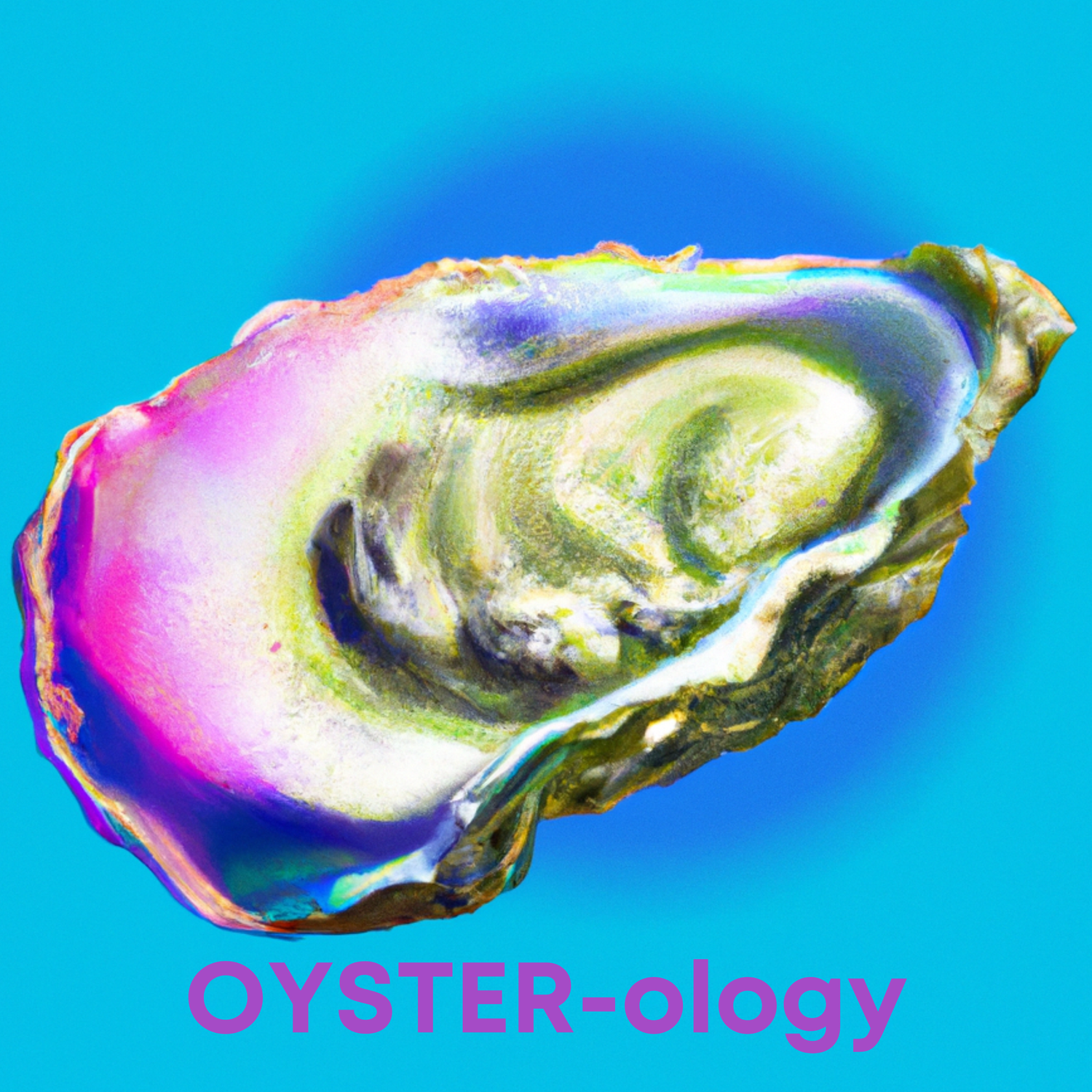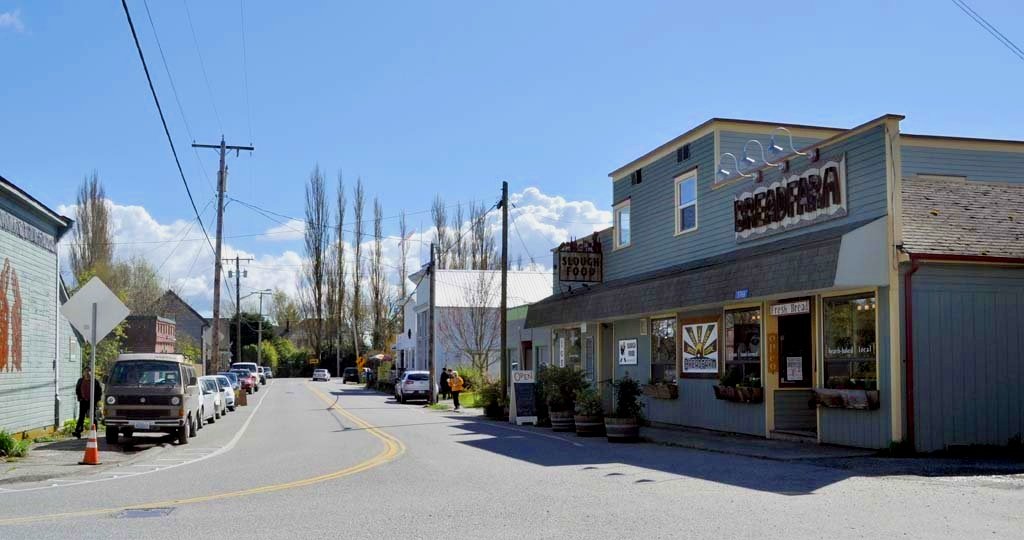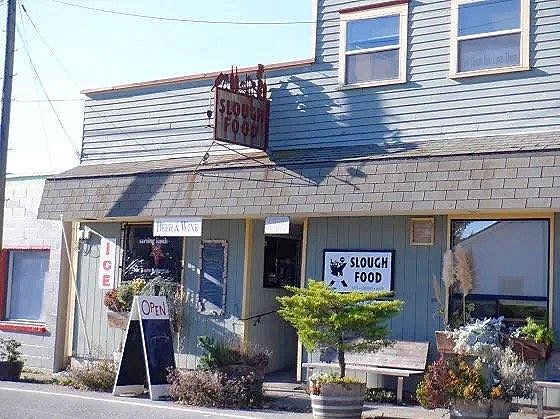It’s not just a party, it’s a Paella Party!
/The tiny town of Bow/Edison WA (population 270) appears almost makeshift, with old barns, houses and a few repurposed sheds leaning just enough to make you wonder if they might fall. Scattered between a few local businesses in this two street village are small art galleries, a couple of restaurants and a killer bakery/coffee shop. And at the corner of the community is Slough Food, a wine and cheese cafe nestled along one of the canals leading to Samish Bay in Washington’s fertile Skagit Valley. A stroll through the small, European-vibe cafe, complete with wine and cheeses, air dried meats and imported sausages, leads to the verandah out back – a partially covered courtyard with small seating areas centered around a long communal table. When I walked in, the verandah was filled with happy people, all enjoying the one and only thing being served on this day: Paella. Because while Slough Food is well respected for its elegantly simple cafe fare of sandwiches and salads, once a month from Spring into Fall it cancels everything and hosts a legendary Paella Party. If that iconic food from Spain does not excite your taste buds then you have come to the wrong place. But if you like enormous pans of food cooked over an open flame and a very chill, outdoor dining atmosphere, then you have arrived at a dining experience that is well worth driving 80 miles from Seattle for lunch.
For the uninitiated to this classic staple of Southern Spain, Paella can come in many variations – some with seafood; others with pork, rabbit, or a combination of all – which may cause purists to recoil. But a few constant components are essential in the creation of any self-respecting paella. First and foremost is the rice that is used and the manner in which it is cooked. Because paella is, above all, a rice dish and Arroz Valenciana is the kind of rice that defines it. With its medium-grain structure (similar to arborio but larger and with less starch), the texture of this rice combined with the absorbed flavors within it, establishes whether the paella is legit. Without Valenciana rice you just can’t get paella right. And paella that’s not right is ¡No Bueno!
Second to the rice used in Paella is the sofrito. This is the base of the dish and the point where you build the flavors into something that – if done right – transforms the taste of paella into something far greater than merely the sum of its parts. Certain things are requisite: good olive oil; Spanish chorizo, saffron, paprika and turmeric. From there the ingredients can vary and, similar to making chili, it is as much a cooking technique as it is a recipe.
As with so many enthusiastic eaters in the US, I find that Paella is often more disappointing than not. The rice is too dry; the proteins or vegetables overcooked and limp; the flavors either too spicy or insipid. Even when making it myself in any one of my several paella pans the end result is often, well, less than anticipated. But not at this Paella Party. The proprietor of Slough Food, R. John DeGloria, knows what memorable outdoor dining is all about. And while his menu typically evokes a taste of Italy with Pacific Northwest characteristics, his Paella Party transports you to Spain.
At the Slough Food Paella Party, Knut Christiansen, the owner/founder of PaellaWorks sticks to the fundamentals with what he calls Paella Mixta. His recipe incorporated the aforementioned traditional requisites which, by its glorious ocher color alone, must have involved fistfulls of saffron, paprika and turmeric. Added to that was lemon citrus; garlic; onions; rosemary; turmeric, red peppers; shishito peppers; asparagus; braised chicken; delicate calamari; and wild shrimp along with freshly harvested mussels and clams from Taylor Shellfish just up the bay.
For the party, Knut and his sous chef, Russell Duncan, prepared four separate pans of paella, which may not sound like all that much until you consider the very large Paelleras they used – each at least a meter in diameter. A Paellera is the special vessel for making its namesake dish, a wide, flat carbon steel pan with “dimples” on the bottom, a slanted lip and simple loop handles on the sides. The pan is hand-hammered and those dimples help distribute the heat in order to attain the critical socarrat – that crispy black fond layer that forms on the bottom of the pan beneath the rice and adds a coveted smokey-but-not-quite-burned flavor to the overall dish. Like wok hei in the world of Asian fried noodles, the socarrat delivers the taste of a truly stellar paella that drives everyone wild. It is a telltale sign that the guy cooking is a paella master rather than a poser. And looking at the black specks scraped off the pan here it was clear that PaellaWorks had it in spades.
My first bite of the paella instantly announced its excellence with a flavor that was at once both citrusy bright and deeply warming. Evenly incorporated, the smoky, vegetal, seafood flavors sang like a choir of Spanish cherubs from the Iberian heavens, delivering a bold, slightly sweet, capsicum-kissed taste without chili heat but with the freshness of the green shishito peppers. The shellfish frolicked with the calamari among the slender almost-crunchy asparagus, heightened by profoundly flavorsome chicken. That first taste was like a stroll along the seaside quay in Alicante, the smells and tastes of the Mediterranean instantly engulfing my gustatory awareness. But it was the rice that held the party together – thick and tender grains, rich in absorbed flavor and smooth to the tooth, with no pasty mouthfeel that marks the downfall of so many paella wannabes. The secret, Knut revealed, was water rather than chicken stock, which allowed the rice to behave as intended, saving its absorption capacity for the clean, unadulterated flavors of the sofrito and additions. Washed down with a pint of Kulshan IPA, it was a revelation.
I’m often hesitant to pronounce the best of anything in food, and especially so when the food of one country tasted best when served in another country by people not from the dish’s original home. But there was no denying the paella at this party, though not in a courtyard somewhere in Valencia, was as good – if not superior to – any I’ve had in the motherland or anywhere else. So…another eighty mile drive for lunch next month? Absolutely.
Slough Food, 5766 Cains Ct. Edison, WA. www.sloughfood.com
PaellaWorks www.paellaworks.com
Photos of Edison courtesy of Joe Mabel and Kyle Collins, respectivly.













